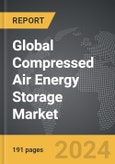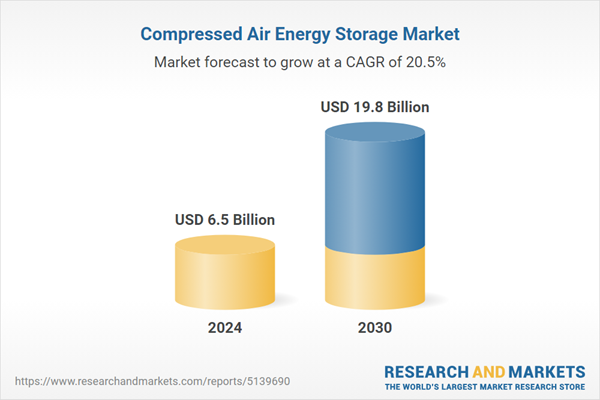The global market for Compressed Air Energy Storage was valued at US$6.5 Billion in 2024 and is projected to reach US$19.8 Billion by 2030, growing at a CAGR of 20.5% from 2024 to 2030. This comprehensive report provides an in-depth analysis of market trends, drivers, and forecasts, helping you make informed business decisions. The report includes the most recent global tariff developments and what they mean for your business.
The market for CAES is growing due to the increasing emphasis on renewable energy and the need for efficient energy storage solutions. As the share of renewable energy in the global energy mix continues to rise, the variability of these sources poses significant challenges for grid stability and reliability. CAES offers a scalable and long-duration storage option that can complement other storage technologies like batteries. Recent advancements in thermodynamic cycles and materials science are enhancing the efficiency and cost-effectiveness of CAES systems. Additionally, regulatory support and government incentives for clean energy projects are driving investments in CAES infrastructure.
The growth in the Compressed Air Energy Storage market is driven by several factors. Firstly, the rising adoption of renewable energy sources is increasing the demand for effective energy storage solutions to ensure grid stability. Secondly, advancements in CAES technology, including improvements in thermodynamic efficiency and storage capacity, are making these systems more viable and attractive. Thirdly, the growing need for long-duration energy storage to manage peak loads and integrate renewable energy is boosting the market for CAES. Lastly, supportive government policies and incentives for clean energy projects are encouraging the development and deployment of CAES systems. These factors collectively contribute to the expanding market for compressed air energy storage.
Segments: End-Use (Renewable Energy Integration, Grid Optimization, T&D Deferral).
Geographic Regions/Countries: World; USA; Canada; Japan; China; Europe; France; Germany; Italy; UK; Rest of Europe; Asia-Pacific; Rest of World.
The analysts continuously track trade developments worldwide, drawing insights from leading global economists and over 200 industry and policy institutions, including think tanks, trade organizations, and national economic advisory bodies. This intelligence is integrated into forecasting models to provide timely, data-driven analysis of emerging risks and opportunities.
Global Compressed Air Energy Storage Market - Key Trends & Drivers Summarized
Compressed Air Energy Storage (CAES) is an innovative technology that addresses the challenges of energy storage and grid stability, particularly in the context of renewable energy integration; grid optimization; and T&D deferrals. CAES systems store energy by compressing air and storing it in underground caverns or large above-ground tanks. When electricity demand is high, the compressed air is released and heated, driving a turbine to generate electricity. This technology is especially valuable for balancing the intermittent nature of renewable energy sources like wind and solar, providing a reliable and flexible means of storing excess energy generated during periods of low demand and releasing it during peak consumption times.The market for CAES is growing due to the increasing emphasis on renewable energy and the need for efficient energy storage solutions. As the share of renewable energy in the global energy mix continues to rise, the variability of these sources poses significant challenges for grid stability and reliability. CAES offers a scalable and long-duration storage option that can complement other storage technologies like batteries. Recent advancements in thermodynamic cycles and materials science are enhancing the efficiency and cost-effectiveness of CAES systems. Additionally, regulatory support and government incentives for clean energy projects are driving investments in CAES infrastructure.
The growth in the Compressed Air Energy Storage market is driven by several factors. Firstly, the rising adoption of renewable energy sources is increasing the demand for effective energy storage solutions to ensure grid stability. Secondly, advancements in CAES technology, including improvements in thermodynamic efficiency and storage capacity, are making these systems more viable and attractive. Thirdly, the growing need for long-duration energy storage to manage peak loads and integrate renewable energy is boosting the market for CAES. Lastly, supportive government policies and incentives for clean energy projects are encouraging the development and deployment of CAES systems. These factors collectively contribute to the expanding market for compressed air energy storage.
Report Scope
The report analyzes the Compressed Air Energy Storage market, presented in terms of units. The analysis covers the key segments and geographic regions outlined below.Segments: End-Use (Renewable Energy Integration, Grid Optimization, T&D Deferral).
Geographic Regions/Countries: World; USA; Canada; Japan; China; Europe; France; Germany; Italy; UK; Rest of Europe; Asia-Pacific; Rest of World.
Key Insights:
- Market Growth: Understand the significant growth trajectory of the Renewable Energy Integration segment, which is expected to reach US$8.8 Billion by 2030 with a CAGR of a 20.7%. The Grid Optimization segment is also set to grow at 17.4% CAGR over the analysis period.
- Regional Analysis: Gain insights into the U.S. market, valued at $2.4 Billion in 2024, and China, forecasted to grow at an impressive 19.3% CAGR to reach $1.4 Billion by 2030. Discover growth trends in other key regions, including Japan, Canada, Germany, and the Asia-Pacific.
Why You Should Buy This Report:
- Detailed Market Analysis: Access a thorough analysis of the Global Compressed Air Energy Storage Market, covering all major geographic regions and market segments.
- Competitive Insights: Get an overview of the competitive landscape, including the market presence of major players across different geographies.
- Future Trends and Drivers: Understand the key trends and drivers shaping the future of the Global Compressed Air Energy Storage Market.
- Actionable Insights: Benefit from actionable insights that can help you identify new revenue opportunities and make strategic business decisions.
Key Questions Answered:
- How is the Global Compressed Air Energy Storage Market expected to evolve by 2030?
- What are the main drivers and restraints affecting the market?
- Which market segments will grow the most over the forecast period?
- How will market shares for different regions and segments change by 2030?
- Who are the leading players in the market, and what are their prospects?
Report Features:
- Comprehensive Market Data: Independent analysis of annual sales and market forecasts in US$ Million from 2024 to 2030.
- In-Depth Regional Analysis: Detailed insights into key markets, including the U.S., China, Japan, Canada, Europe, Asia-Pacific, Latin America, Middle East, and Africa.
- Company Profiles: Coverage of players such as Siemens Energy AG, Pacific Gas & Electric Company, Hydrexia, Hydrostor, Inc., Korea Electric Power Corporation (KEPCO) and more.
- Complimentary Updates: Receive free report updates for one year to keep you informed of the latest market developments.
Some of the 27 companies featured in this Compressed Air Energy Storage market report include:
- Siemens Energy AG
- Pacific Gas & Electric Company
- Hydrexia
- Hydrostor, Inc.
- Korea Electric Power Corporation (KEPCO)
- NRStor, Inc.
- MAN Energy Solutions SE
- Enel Green Power SpA
- Gravitricity
Tariff Impact Analysis: Key Insights for 2025
Global tariff negotiations across 180+ countries are reshaping supply chains, costs, and competitiveness. This report reflects the latest developments as of April 2025 and incorporates forward-looking insights into the market outlook.The analysts continuously track trade developments worldwide, drawing insights from leading global economists and over 200 industry and policy institutions, including think tanks, trade organizations, and national economic advisory bodies. This intelligence is integrated into forecasting models to provide timely, data-driven analysis of emerging risks and opportunities.
What’s Included in This Edition:
- Tariff-adjusted market forecasts by region and segment
- Analysis of cost and supply chain implications by sourcing and trade exposure
- Strategic insights into geographic shifts
Buyers receive a free July 2025 update with:
- Finalized tariff impacts and new trade agreement effects
- Updated projections reflecting global sourcing and cost shifts
- Expanded country-specific coverage across the industry
Table of Contents
I. METHODOLOGYII. EXECUTIVE SUMMARY2. FOCUS ON SELECT PLAYERSIII. MARKET ANALYSISIV. COMPETITION
1. MARKET OVERVIEW
3. MARKET TRENDS & DRIVERS
4. GLOBAL MARKET PERSPECTIVE
UNITED STATES
CANADA
JAPAN
CHINA
EUROPE
FRANCE
GERMANY
ITALY
UNITED KINGDOM
REST OF EUROPE
ASIA-PACIFIC
REST OF WORLD
Companies Mentioned (Partial List)
A selection of companies mentioned in this report includes, but is not limited to:
- Siemens Energy AG
- Pacific Gas & Electric Company
- Hydrexia
- Hydrostor, Inc.
- Korea Electric Power Corporation (KEPCO)
- NRStor, Inc.
- MAN Energy Solutions SE
- Enel Green Power SpA
- Gravitricity
Table Information
| Report Attribute | Details |
|---|---|
| No. of Pages | 191 |
| Published | April 2025 |
| Forecast Period | 2024 - 2030 |
| Estimated Market Value ( USD | $ 6.5 Billion |
| Forecasted Market Value ( USD | $ 19.8 Billion |
| Compound Annual Growth Rate | 20.5% |
| Regions Covered | Global |









